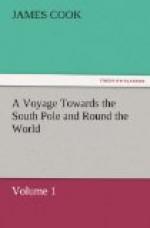by dark dense clouds, and seemed to forebode much
wind. This occasioned as to clew up all our sails,
and presently after six water-spouts were seen.
Four rose and spent themselves between us and the
land; that is, to the south-west of us, the fifth was
without us, the sixth first appeared in the south-west,
at the distance of two or three miles at least from
us. Its progressive motion was to the north-east,
not in a straight but in a crooked line, and passed
within fifty yards of our stern, without our feeling
any of its effects. The diameter of the base of
this spout I judged to be about fifty or sixty feet;
that is, the sea within this space was much agitated,
and foamed up to a great height. From this a
tube, or round body, was formed, by which the water
or air, or both, was carried in a spiral stream up
to the clouds. Some of our people said they saw
a bird in the one near us, which was whirled round
like the fly of a jack, as it was carried upwards.
During the time these spouts lasted, we had now and
then light puffs of wind from all points of the compass,
with some few slight showers of rain, which generally
fell in large drops; and the weather continued thick
and hazy for some hours after, with variable light
breezes of wind. At length the wind fixed in its
old point, and the sky resumed its former serenity.
Some of these spouts appeared at times to be stationary;
and at other times to have a quick but very unequal
progressive motion, and always in a crooked line, sometimes
one way and sometimes another; so that, once or twice,
we observed them to cross one another. From the
ascending motion of the bird, and several other circumstances,
it was very plain to us that these spouts were caused
by whirlwinds, and that the water in them was violently
hurried upwards, and did not descend from the clouds
as I have heard some assert. The first appearance
of them is by the violent agitation and rising up of
the water; and, presently after, you see a round column
or tube forming from the clouds above, which apparently
descends till it joins the agitated water below.
I say apparently, because I believe it not to be so
in reality, but that the tube is already formed from
the agitated water below, and ascends, though at first
it is either too small or too thin to be seen.
When the tube is formed, or becomes visible, its apparent
diameter increaseth till it is pretty large; after
that it decreaseth, and at last it breaks or becomes
invisible towards the lower part. Soon after the
sea below resumes its natural state, and the tube
is drawn, by little and little, up to the clouds,
where it is dissipated. The same tube would sometimes
have a vertical, and sometimes a crooked or inclined
direction. The most rational account I have read
of water-spouts, is in Mr Falconer’s Marine Dictionary,
which is chiefly collected from the philosophical writings
of the ingenious Dr Franklin. I have been told
that the firing of a gun will dissipate them; and
I am very sorry I did not try the experiment, as we
were near enough, and had a gun ready for the purpose;
but as soon as the danger was past, I thought no more
about it, being too attentive in viewing these extraordinary
meteors At the time this happened, the barometer stood
at 29, 75, and the thermometer at 56.




